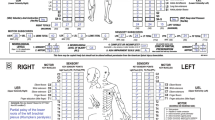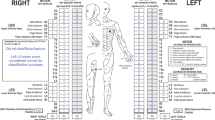Abstract
Study design
Prospective, observational study.
Objectives
The International Standards for Neurological Classification of Spinal Cord Injury (ISNCSCI) represent the gold standard for the assessment of patients with spinal cord injury (SCI) and their measurement properties have been evaluated in patients with traumatic lesions. Albeit the ISNCSCI are widely used also for the assessment and prognosis of patients with non-traumatic SCI, a validation of this grading system in this sample has never been performed. Therefore, the aim of this study is to evaluate the measurement properties of the ISNCSCI in a population of persons with non-traumatic SCI.
Setting
Three Italian rehabilitation hospitals.
Methods
The sample included 140 patients with non-traumatic SCI of different etiology, level and grade, for a total of 169 evaluations performed by two examiners. Cronbach’s Alpha was used to evaluate the internal consistency of the ISNCSCI various components. The agreement between two examiners of each center in the definition of different components was used to assess the inter-rater reliability. The construct validity was evaluated through the correlation of the ISNCSCI with the Spinal Cord Independence Measure (SCIM).
Results
The ISNCSCI showed substantial internal consistency, and substantial inter-rater agreement for AIS grade, cumulative motor and sensory scores. The motor scores for upper and lower extremity showed fair to moderate correlation with SCIM self-care and motility subscores, respectively. The ISNCSCI total motor score correlated with the total SCIM score.
Conclusions
Our study demonstrates that the ISNCSCI are a valid and reliable tool for the assessment of patients with non-traumatic SCI.
Similar content being viewed by others
Log in or create a free account to read this content
Gain free access to this article, as well as selected content from this journal and more on nature.com
or
Data availability
Data are available upon reasonable request.
References
ASIA and ISCoS International Standards Committee. The 2019 revision of the International Standards for Neurological Classification of Spinal Cord Injury (ISNCSCI)—What’s new? Spinal Cord. 2019;57,:815–7.
ASIA. International Standards for Neurological Classification of Spinal Cord Injury. Chicago: ASIA; 2019.
Ditunno JF. The John Stanley Coulter Lecture. Predicting recovery after spinal cord injury: a rehabilitation imperative. Jf rch Phys Med Rehabil. 1999;80:361–4.
Marino RJ, Burns S, Graves DE, Leiby BE, Kirshblum S, Lammertse DP. Upper- and lower-extremity motor recovery after traumatic cervical spinal cord injury: an update from the national spinal cord injury database. Arch Phys Med Rehabil. 2011;92:369–75.
van Middendorp JJ, Hosman AJ, Donders AR, Pouw MH, Ditunno JF Jr, Curt A, et al. A clinical prediction rule for ambulation outcomes after traumatic spinal cord injury: a longitudinal cohort study. Lancet. 2011;377:1004–10.
Pavese C, Schneider MP, Schubert M, Curt A, Scivoletto G, Finazzi-Agrò E, et al. Prediction of bladder outcomes after traumatic spinal cord injury: a longitudinal cohort study. PLoS Med. 2016;13:e1002041. 17
Pavese C, Bachmann LM, Schubert M, Curt A, Mehnert U, Schneider MP, et al. Bowel Outcome Prediction After Traumatic Spinal Cord Injury: Longitudinal Cohort Study. Neurorehabil Neural Repair. 2019;33:902–10.
ASIA. Standards for Neurological Classification of Spinal Injured Patients. Chicago: ASIA;1982.
ASIA. Standards for Neurological Classification of Spinal Injured Patients. Chicago: ASIA;1984.
ASIA. Standards for Neurological Classification of Spinal Injured Patients. Chicago:ASIA;1989.
ASIA. Standards for Neurological Classification of Spinal Injured Patients. Chicago:ASIA;1992.
ASIA. International Standards for Neurological Classification of Spinal Injured Patients. Chicago:ASIA;1996.
ASIA. International Standards for Neurological Classification of Spinal Injured Patients. Chicago:ASIA;2000.
ASIA. International Standards for Neurological Classification of Spinal Cord Injury. Chicago:ASIA;2002.
Steeves JD, Lammertse D, Curt A, Fawcett JW, Tuszynski MH, Ditunno JF, et al. Guidelines for the conduct of clinical trials for spinal cord injury (SCI) as developed by the ICCP panel: clinical trial outcome measures. Spinal Cord. 2007;45:206–21.
New PW, Cripps RA, Bonne, Lee B. Global maps of non-traumatic spinal cord injury epidemiology: towards a living data repository. Spinal Cord. 2014;52:97–109.
Niemi-Nikkola V, Koskinen E, Väärälä E, Kauppila AM, Kallinen M, Vainionpää A. Incidence of Acquired Nontraumatic Spinal Cord Injury in Finland: a 4-Year Prospective Multicenter Study. Arch Phys Med Rehabil. 2021;102:44–49.
Scivoletto G, Farchi S, Laurenza L, Molinari M. Traumatic and non-traumatic spinal cord lesions: an Italian comparison of neurological and functional outcomes. Spinal Cord. 2011;49:391–6.
Gupta A, Taly AB, Srivastava A, Murali T. Non-traumatic spinal cord lesions: epidemiology, complications, neurological and functional outcome of rehabilitation. Spinal Cord. 2009;47:307–11.
Sturt R, Hill B, Holland A, New PW, Bevans C. Validation of a clinical prediction rule for ambulation outcome after non-traumatic spinal cord injury. Spinal Cord. 2020;58:609–15.
Scivoletto G, Pavese C, Bachmann LM, Schubert M, Curt A, Finazzi Agro E, et al. Prediction of bladder outcomes after ischemic spinal cord injury: a longitudinal cohort study from the European multicenter study about spinal cord injury. Neurourol Urodyn. 2018;37:1779–84.
New PW, Inge E-H, Scivoletto G, Reeves RK, Townson A, Marshall R, et al. Imprtant Clinical Rehabilitation Principles Unique to People with non-traumatic Spinal Cor Dysfuncion. Top Spinal Cord Injury Rehabilit. 2017;23:299–312.
American Spinal Injury Association (ASIA). International Standards for Neurological Classification of Spinal Cord Injury. 7th ed. Updated 2015. Atlanta: American Spinal Injury Association; 2015.
Anderson K, Aito S, Atkins M, Biering-Sørensen F, Charlifue S, Curt A, et al. Functional Recovery Outcome Measures Work Group. Functional recovery measures for spinal cord injury: an evidence-based review for clinical practice and research. J Spinal Cord Med. 2008;31:133–44.
Arrigoni C, Puci M, Grugnetti AM, Collivasone L, Fenizia E, Borrelli P, et al. Italian version of Nursing Students’ Perception of Instructor Caring (I-NSPIC): assessment of reliability and validity. BMC Medical Education. 2017;17:218.
de Souza AC, Costa Alexandre NM, de Brito Guirardello E. Psychometric properties in instruments evaluation of reliability and validity. Epidemiol Serv Saude, Brasília. 2017;26:649–659.
Altman DG. Practical statistics for medical research. London: Champan and Hall; 1991.
Meier AH, Gruessner A, Cooney RN. Using the ACGME Milestones for Resident Self-Evaluation and Faculty Engagement. J Surg Educ. 2016;73:e150–e157. Nov-Dec
Landis JR, Koch GG. The measurement of observer agreement for categorical data. Biometrics. 1977;33:159–74.
Scivoletto G, Torre M, Mammone A, Maier DD, Weidner N, Schubert M, et al. Acute Traumatic and Ischemic Spinal Cord Injuries Have a Comparable Course of Recovery. Neurorehabil Neural Repair. 2020;34:723–32.
Cohen ME, Bartko JJ. Reliability of ISCSCI-92 for neurological classification of spinal cord injury. Reference Manual for the International Standards for Neurological and Functional Classification of Spinal Cord Injury. In: Ditunno JF, Donovan WH, Maynard FM, editors. Chicago, IL: American Spinal Injury Association: s.n., 1994. p. 59–65.
Marino RJ, Jones L, Kirshblum S, Tal J, Dasgupta A. Reliability and Repeatability of the Motor and sensory Examination of the International Standards for Neurological Classification of Spinal Cord Injury. J Spinal Cord Med. 2008;31:166–70.
Jonsson M, Tollbäck A, Gonzales H, Borg J. Inter-rater reliability of the 1992 international standards for neurological and functional classification of incomplete spinal cord injury. Spinal Cord. 2000;38:675–9.
Savic G, Bergstrom EMK, Frankel HL, Jamous MA, Jones PW. Inter-rater reliability of motor and sensory examinations performed according to American Spinal Injury Association standards. Spina Cord. 2007;45:444–51.
Schuld C, Franz S, van Hedel HJA, Moosburger J, Maier D, Abel R, et al. International standards for neurological classification of spinal cord injury: classification skills of clinicians versus computational algorithms. Spinal Cord. 2015;53:324–31.
ASIA International Standards Committee, ASIA Education Committee, Rupp R. Assessor accuracy of the International Standards for Neurological Classification of Spinal Cord Injury (ISNCSCI)—recommendations for reporting items. Spinal Cord. 2018;56:819–20.
Marino RJ, Huang M, Knight P, Herbison GJ, Ditunno JF, Segal M. Assessing self-care status in quadriplegia: comparison of the Quadriplegia Index of Function (QIF) and the Functional Independence Measure (FIM). Paraplegia. 1993;31:225–33.
Marino RJ, Goin JE. Development of a short-form Quadriplegia Index of Function scale. Spinal Cord. 1999;37:289–96.
Yavuzer G, Suldur N, Kuçukdeveci AA, Elhan A. The role of Functional Independence Measure and Modified Barthel Index in the assessment of neurorehabilitation patients in Turkey [in Turkish]. J Rheum Med Rehabil. 2000;11:26–31.
Kuçukdeveci AA, Yavuzer G, Tennant A, Suldur N, Sonel B, Arasil T. Adaptation of the modified Barthel Index for use in physical medicine and rehabilitation in Turkey. Scand. J Rehabil Med. 2000;32:87–92.
Marino RJ, Graves DE. Metric properties of the ASIA motor score: subscales improve correlation with functional activities. Arch Phys Med Rehabil. 2004;85:1804–10.
Wirth B, van Hedel HJ, Kometer B, Dietz V, Curt A. Changes in activity after a complete spinal cord injury as measured by the Spinal Cord Independence Measure II (SCIM II). Am J Physiol Regul Integr Comp Physiol. 2007;292:R1246–R1253.
DiGiovanna AG. Human Ageing: biological perspectives. 2nd ed. New York, NY: McGraw-Hill; 2000.
Jakob W, Wirz M, van Hedel HJ, Dietz V, EM-SCI Study Group. Difficulty of elderly SCI subjects to translate motor recovery—“body function”—into daily living activities. J Neurotrauma. 2009;26:2037–44.
Scivoletto G, Masciullo M, Pichiorri F, Tamburella F, Molinari M. Impact of complications at admission to rehabilitation on the functional status of patients with spinal cord lesion. Spinal Cord. 2020;58:1282–90.
Horn SD, Smout RJ, DeJong G, Dijkers MP, Hsieh CH, Lammertse D, et al. Association of various comorbidity measures with spinal cord injury rehabilitation outcomes. Arch Phys Med Rehabil. 2013;94:S75–86.
Elliott TR, Frank RG. Depression following spinal cord injury. Arch Phys Med Rehabil. 1996;77:816–23.
Kim KD, Lee KS, Coric D, Chang JJ, Harrop JS, Theodore N, et al. A study of probable benefit of a bioresorbable polymer scaffold for safety and neurological recovery in patients with complete thoracic spinal cord injury: 6-month results from the INSPIRE study. J Neurosurg Spine. 2021;5:1–10.
Derakhshanrad N, Saberi S, Yekaninejad MS, Joghataei MT, Sheikhrezaei A. Granulocyte-colony stimulating factor administration for neurological improvement in patients with postrehabilitation chronic incomplete traumatic spinal cord injuries: a double-blind randomized controlled clinical trial. J Neurosurg Spine. 2018;29:97–107.
Acknowledgements
The authors would like to thank all patients who were willing to contribute to the database. The authors would also like to acknowledge the help and suggestions of Dr Carlotte Kiekens, Giulia Furlini, Francesco Coschignano, Floriana Pichiorri, Marco Molinari.
Author information
Authors and Affiliations
Contributions
GS, EL, CP, and IB were responsible for designing the conceptual framework of the study. GS, CP, and MVP conducted the statistical analysis. GS, CP, and IB prepared the paper. EL, GM, SV, MM, BA, and GF substantially contributed to the data recording and interpretation and the article preparation.
Corresponding author
Ethics declarations
Ethical approval
The study was approved by the ethic committee of IRCCS Fondazione Santa Lucia. We certify that all applicable institutional and governmental regulations concerning the ethical use of human volunteers/animals were followed during the course of this research.
Funding
The paper is partially supported by the ERANET-NEURON grant to Giorgio Scivoletto.
Competing interests
The authors declare no competing interests.
Additional information
Publisher’s note Springer Nature remains neutral with regard to jurisdictional claims in published maps and institutional affiliations.
Supplementary information
Rights and permissions
About this article
Cite this article
Lena, E., Baroncini, I., Pavese, C. et al. Reliability and validity of the international standards for neurological classification of spinal cord injury in patients with non-traumatic spinal cord lesions. Spinal Cord 60, 30–36 (2022). https://doi.org/10.1038/s41393-021-00675-9
Received:
Revised:
Accepted:
Published:
Issue date:
DOI: https://doi.org/10.1038/s41393-021-00675-9
This article is cited by
-
The role of comprehensive rehabilitation in the care of degenerative cervical myelopathy
Spinal Cord (2024)
-
Classification of upper-limb dysfunction severity and prediction of independence in activities of daily living after cervical spinal-cord injury
Spinal Cord (2024)
-
Accuracy of self-reported severity and level of spinal cord injury
Spinal Cord (2022)



